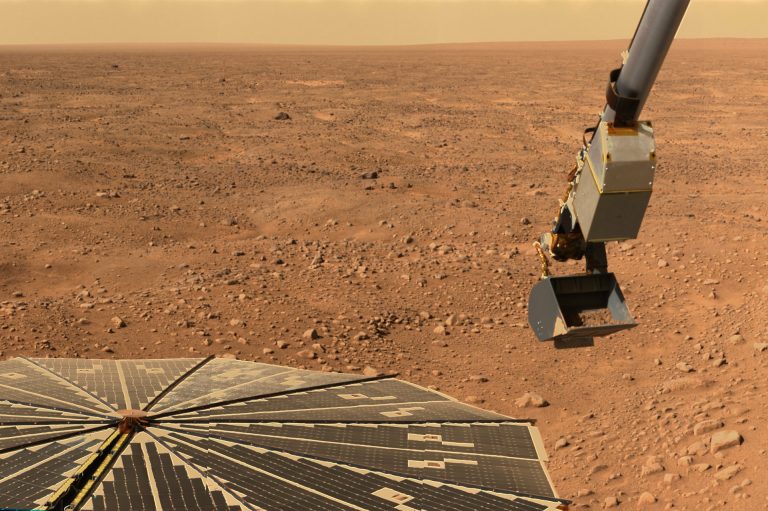InSight and Perseverance are two NASA robots that are presently exploring the Martian surface. InSight landed on the red planet on Nov. 26, 2018; it’s been active for 977 days as of July 30. Perseverance landed on Feb. 18, 2021; it’s been operational for 162 days. Recently, scientists announced new information about Mars from data collected by these robots.
Three newly published papers authored by dozens of scientists from around the world describe how they used InSight’s seismometer to take a deeper look at Mars. A July 21 press conference revealed the research results from Perseverance.
InSight
From February 2019, the InSight lander has been recording seismic activity or “quakes” that occur on the planet. In a November 2018 National Geographic interview, Renee Weber, from NASA’s Marshall Space Flight Center, said that one of the primary goals of the mission was to figure out the level of seismic activity on Mars. The mission also sought to measure the planet’s core and other layers beneath the surface.
“That is something that we don’t actually know. That’s basically how many quakes there are, how often they occur, where they occur, how big they are,” Weber said.
InSight’s seismometer picks up two kinds of waves during a Mars quake: P-waves and S-waves. Each wave moves through the Martian interiors in slightly different ways from each other. That movement depends on what kind of material they are moving through.
Success
You are now signed up for our newsletter
Success
Check your email to complete sign up
Just like 1’s and 0’s can be utilized to create complex computer programming, these two waves can combine to generate a complex picture of the planet’s interior. By analyzing these waves, scientists can understand the internal composition of Mars.
Previously, scientists relied on satellites flying above the planet to measure gravitational differences and topography. Based on such data, the crust thickness of Mars was estimated to be a global average of 68 miles (110 km).
However, one of the three recent papers that modeled the red planet’s crust found that the calculation was incorrect.
“Now with our measurements from inside, we can say that that’s definitely too much,” Brigitte Knapmeyer-Endrun, lead author, told Wired. Brigitte and her group of researchers calculate the maximum average thickness of the crust to be 45 miles (72 km).
The researchers believe that the crust might be composed of two or maybe three layers. The first layer is assumed to be 6.2 miles (10 km) thick; the second layer stretches to around 12.4 miles (20 km). Although the research team is not sure about what lies beyond the second layer, Knapmeyer-Endrun told the media outlet that “the crust is not as thick as it had been predicted previously, and it has a lower density.”
Planetary seismologist Simon Stahler and his team worked to understand the innermost core of Mars. They estimated the depth of the core by measuring the S-waves that bounced off the boundary of the core and the mantle. The team calculates the core to be at a depth of around 963 miles (1,550 km) from the planet’s surface. Their paper reported a core radius of 1,137 miles (1,830 km).
Perseverance
The other robot on Mars, Perseverance, is equipped with a seven-foot arm that has several gadgets to conduct experiments on the red planet. For example, the MOXIE (Mars Oxygen In-Situ Resource Utilization Experiment) unit is capable of converting small amounts of atmospheric carbon dioxide into oxygen. It has high-resolution cameras that take pictures of its surroundings and highly sensitive sensors that measure the climate.
Perseverance’s AI-powered software has helped the robot move through the planet with relative ease. Human-controlled driving maneuvers the Perseverance around difficult terrain or obstacles at the rate of 100 feet per day. The AI software can also improve its agility. While the rover runs, the AI also creates a three-dimensional map of the surface so that the daily route is updated and optimized in real-time.
Vivian Sun, the systems engineer at NASA’s Jet Propulsion Laboratory, spoke at the July 21 press conference. She said that it was a challenge to figure out “where we want to go and how we’re going to fit everything into our schedule.”
Perseverance was taken on a detour of 3,000 feet south of the landing site on a mission to recover rock samples. The scientists plan to store samples on the planet’s surface and then retrieve them during some future return mission.
Perseverance landed on the Jezero Crater, which is believed to have once been a lake. It has taken images of numerous rocks, some of them resembling hardened lake mud. It’s speculated that it may have signs of a former life.
In an interview with Wired, Caltech geochemist Ken Farley stated that the most surprising observation so far is evidence of varying water levels in the crater and flash flooding. It suggests that the crater underwent multiple phases of water drying up and then getting filled in with water again.
Following its current expedition south of the landing site, Perseverance is set to make its way northwest towards what is believed to be an old river delta that used to feed water into the Jezero Crater. The place might help scientists understand how water flowed in the region.















